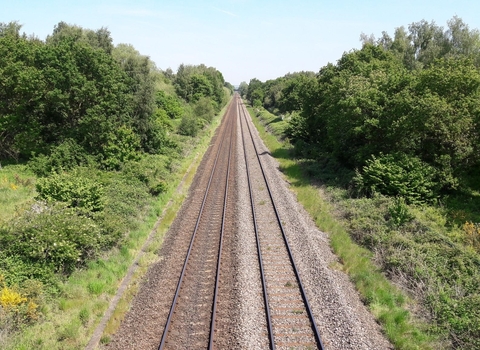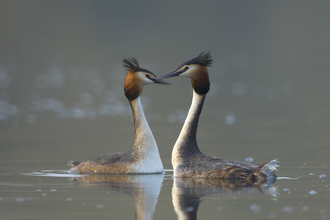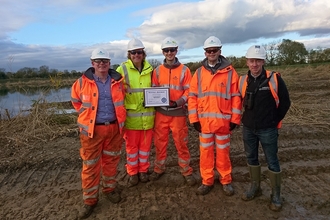How to create and implement a trackside biodiversity plan across a vast area?
Network Rail is one of the UK’s largest landowners. In 2018, they launched a Biodiversity Action Plan (BAP) with key targets of no net loss in biodiversity on their lineside estate by 2024 and to achieve plus 10% biodiversity net gain on each route by 2035.
To achieve these targets in their Eastern Region, their regional team wanted to actively engage key stakeholders to explore opportunities for collaboration. These partnerships will help shape and inform ongoing decision-making and long-term environmental strategies across the region.
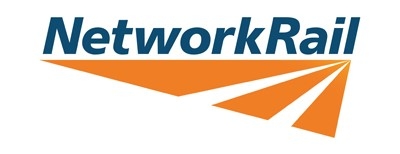
The Wildlife Trusts are helping Network Rail create a thriving future for nature along 6,000 km of track.
However, the scale of Network Rail’s Eastern Region is vast, extending from London to the Scottish border, comprising 6,000 km of track and 15,688 hectares of land, which includes national parks, Areas of Outstanding Natural Beauty, and 60 Sites of Special Scientific Interest.
Network Rail’s Eastern Region appointed The Wildlife Trusts on a three-year project to help implement their regional biodiversity plan required to support the ongoing management of lineside and non-lineside vegetation. Network Rail recognised the unique on-the-ground engagement opportunities and expertise offered by The Wildlife Trusts, as well as practical ecological expertise to help reach their over-arching targets.
Solution: Dedicated Ecological Support
Dedicated ecological support was essential to meet Network Rail’s ambitious biodiversity goals. East Midlands Environmental Consultants Ltd (EMEC Ecology), the consultancy subsidiary of Nottinghamshire Wildlife Trust, led the delivery of the project, with the collaboration of four other Wildlife Trust Consultancies across the Eastern Region (EcoNorth in Northumberland, Future Nature in the home counties, Wildscapes in Yorkshire and Wilder Ecology in East Anglia).
The team consisted of eight ecologists, a dedicated engagement manager and a project manager. Using a combination of data collection, survey tool configuration and spatial analysis, the engagement manager was able engage stakeholders managing sites for biodiversity within a 1km buffer zone of the railway.
The ecologists then worked closely with Network Rail’s Regional Ecologist to design and create Habitat Management Plans (HMPs), Sectional Asset Plans (SAPs) and Biodiversity Asset Plans (BAsPs) to ensure stakeholder engagement data directly informs future route-level habitat management. This will help Network Rail meet their biodiversity targets in the best possible way for nature.
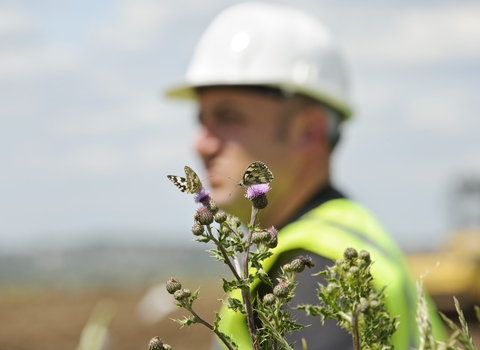
Terry Whittaker/2020VISION
The Wildlife Trusts Consultancies
The Wildlife Trust Consultancies is a trusted network of local experts in ecology, landscape architecture, and habitat management. They specialise in providing practical, responsive solutions for risk management and planning, carefully tailored to local conditions.
Wildlife Trust Consultancies offer extensive experience in managing local projects and guiding our clients through complex regulatory and planning frameworks.
We support developers, architects, and planners at every stage, from site selection to wildlife surveys and mitigation strategies, working closely with Local Planning Authorities, Natural England, and the Environment Agency.
Reach within communities allows for informed decision-making
To engage local stakeholders and gather essential data to inform route-level habitat management, the project team employed the reach of 16 Wildlife Trusts within their communities to promote and host a series of webinars. These webinars successfully attracted over 1,700 stakeholders across 16 counties, and included conservation charities, nature experts, local authorities, and major landowners.
This presented invaluable possibilities for collaboration and EMEC developed a biodiversity data collection survey for distribution. Crucially, this included a GIS (Geographical Information System) mapping of stakeholder sites for biodiversity, while multiple Wildlife Trusts also contributed their local knowledge and conservation expertise to the questionnaire.
This equips Network Rail’s Eastern region with the local knowledge, expertise and stakeholder input needed to deliver its biodiversity net gain target by 2035.
© Network Rail
The Wildlife Trusts: national scope, local reach
The Royal Society of Wildlife Trusts (RSWT) acts as the coordinating body for the 46 individual Wildlife Trusts across the UK and 24 Wildlife Trust Consultancies. RSWT provides strategic oversight, facilitates collaboration and advocates for wildlife conservation on a national scale. In the Eastern Region, multiple Wildlife Trusts contributed their local knowledge and conservation expertise to support EMEC in delivering the biodiversity engagement effectively.

